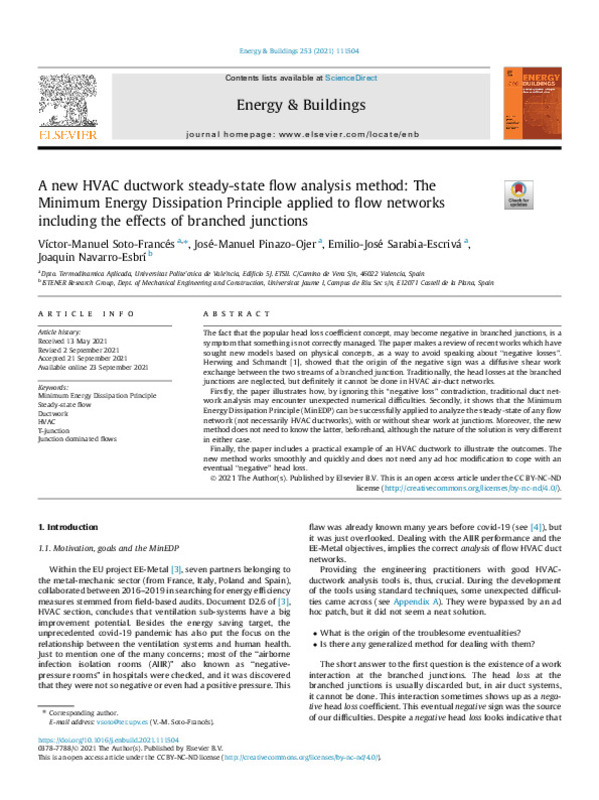JavaScript is disabled for your browser. Some features of this site may not work without it.
Buscar en RiuNet
Listar
Mi cuenta
Estadísticas
Ayuda RiuNet
Admin. UPV
A new HVAC ductwork steady-state flow analysis method: The Minimum Energy Dissipation Principle applied to flow networks including the effects of branched junctions
Mostrar el registro sencillo del ítem
Ficheros en el ítem
| dc.contributor.author | Soto Francés, Víctor Manuel
|
es_ES |
| dc.contributor.author | Pinazo Ojer, José Manuel
|
es_ES |
| dc.contributor.author | Sarabia Escrivà, Emilio José
|
es_ES |
| dc.contributor.author | Navarro-Esbrí, Joaquín
|
es_ES |
| dc.date.accessioned | 2023-09-25T18:01:49Z | |
| dc.date.available | 2023-09-25T18:01:49Z | |
| dc.date.issued | 2021-12-15 | es_ES |
| dc.identifier.issn | 0378-7788 | es_ES |
| dc.identifier.uri | http://hdl.handle.net/10251/197086 | |
| dc.description.abstract | [EN] The fact that the popular head loss coefficient concept, may become negative in branched junctions, is a symptom that something is not correctly managed. The paper makes a review of recent works which have sought new models based on physical concepts, as a way to avoid speaking about "negative losses". Herwing and Schmandt [1], showed that the origin of the negative sign was a diffusive shear work exchange between the two streams of a branched junction. Traditionally, the head losses at the branched junctions are neglected, but definitely it cannot be done in HVAC air-duct networks. Firstly, the paper illustrates how, by ignoring this "negative loss" contradiction, traditional duct network analysis may encounter unexpected numerical difficulties. Secondly, it shows that the Minimum Energy Dissipation Principle (MinEDP) can be successfully applied to analyze the steady-state of any flow network (not necessarily HVAC ductworks), with or without shear work at junctions. Moreover, the new method does not need to know the latter, beforehand, although the nature of the solution is very different in either case. Finally, the paper includes a practical example of an HVAC ductwork to illustrate the outcomes. The new method works smoothly and quickly and does not need any ad hoc modification to cope with an eventual "negative" head loss. (c) 2021 The Author(s). Published by Elsevier B.V. This is an open access article under the CC BY-NC-ND license (http://creativecommons.org/licenses/by-nc-nd/4.0/). | es_ES |
| dc.language | Inglés | es_ES |
| dc.publisher | Elsevier | es_ES |
| dc.relation.ispartof | Energy and Buildings | es_ES |
| dc.rights | Reconocimiento - No comercial - Sin obra derivada (by-nc-nd) | es_ES |
| dc.subject | Minimum Energy Dissipation Principle | es_ES |
| dc.subject | Steady-state flow | es_ES |
| dc.subject | Ductwor | es_ES |
| dc.subject | HVAC | es_ES |
| dc.subject | T-junction | es_ES |
| dc.subject | Junction dominated flows | es_ES |
| dc.subject.classification | MAQUINAS Y MOTORES TERMICOS | es_ES |
| dc.title | A new HVAC ductwork steady-state flow analysis method: The Minimum Energy Dissipation Principle applied to flow networks including the effects of branched junctions | es_ES |
| dc.type | Artículo | es_ES |
| dc.identifier.doi | 10.1016/j.enbuild.2021.111504 | es_ES |
| dc.rights.accessRights | Abierto | es_ES |
| dc.contributor.affiliation | Universitat Politècnica de València. Escuela Técnica Superior de Ingenieros Industriales - Escola Tècnica Superior d'Enginyers Industrials | es_ES |
| dc.description.bibliographicCitation | Soto Francés, VM.; Pinazo Ojer, JM.; Sarabia Escrivà, EJ.; Navarro-Esbrí, J. (2021). A new HVAC ductwork steady-state flow analysis method: The Minimum Energy Dissipation Principle applied to flow networks including the effects of branched junctions. Energy and Buildings. 253:1-15. https://doi.org/10.1016/j.enbuild.2021.111504 | es_ES |
| dc.description.accrualMethod | S | es_ES |
| dc.relation.publisherversion | https://doi.org/10.1016/j.enbuild.2021.111504 | es_ES |
| dc.description.upvformatpinicio | 1 | es_ES |
| dc.description.upvformatpfin | 15 | es_ES |
| dc.type.version | info:eu-repo/semantics/publishedVersion | es_ES |
| dc.description.volume | 253 | es_ES |
| dc.relation.pasarela | S\448714 | es_ES |
| dc.contributor.funder | Universitat Politècnica de València | es_ES |








